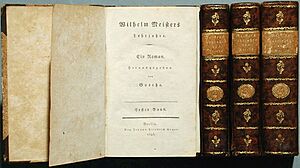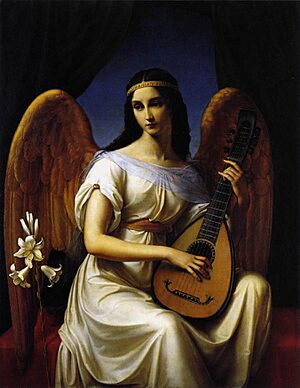Wilhelm Meister's Apprenticeship facts for kids
Wilhelm Meister's Apprenticeship (German: Wilhelm Meisters Lehrjahre) is a famous novel by Johann Wolfgang von Goethe. It was first published in 1795–96. This story follows a young man named Wilhelm Meister as he tries to find his place in the world. He learns a lot about himself and life through his experiences.
Contents
Discovering Wilhelm Meister's Apprenticeship
This novel is about Wilhelm's journey of self-discovery. He wants to escape his ordinary business life. Instead, he dreams of a life in the theater. His adventures lead him to meet many interesting people. He learns important lessons about art, friendship, and growing up.
Wilhelm's Journey: A Story Overview
The novel is divided into eight books. We will look at the first five books. They show Wilhelm's path as he explores his dreams and faces challenges.
Early Dreams and Puppet Shows
Wilhelm loves the theater from a young age. He remembers a puppet show his mother put on. This show made him fascinated with acting. He spends hours practicing plays with his friends. His family wants him to work in business. But Wilhelm dreams of a different life. He has a secret relationship with an actress named Mariane. He plans to run away with her. However, he finds a note that makes him doubt her feelings. This makes him very sad and confused.
Joining the Traveling Performers
After his disappointment, Wilhelm leaves home. He joins a group of traveling actors. Here, he meets many new people. He becomes friends with Philine and Laertes. He also meets Mignon, a mysterious and talented child. Wilhelm feels a strong connection to Mignon. He decides to take care of her like his own child. He also meets the Harper, an old musician. Wilhelm starts to learn more about the world of theater.
Life at the Castle Theater
The acting troupe gets a special invitation. They are asked to perform at a grand castle. Wilhelm meets important people there, like the Count and Countess. He also meets Jarno, a wise officer. Jarno encourages Wilhelm to read the plays of William Shakespeare. Wilhelm becomes deeply interested in Shakespeare's works. He spends a lot of time studying them. The theater group faces many challenges and disagreements at the castle. Wilhelm tries his best to keep everyone working together. He learns about the ups and downs of life as a performer.
Leading the Troupe and New Friends
Wilhelm takes on a bigger role in the theater group. He helps them prepare for their plays. During their travels, the group faces a dangerous attack. Wilhelm gets injured during this event. A kind woman, known as the "Amazon," helps him. He is very impressed by her. Wilhelm continues to study Shakespeare's plays, especially Hamlet. He meets Serlo, another theater director, and his sister, Aurelie. Wilhelm has many deep conversations with them about acting and life.
The Hamlet Production and New Paths
Wilhelm receives sad news about his father's death. This makes him think seriously about his future. He decides to fully commit to a life in the theater. He signs a contract with Serlo. Together, they work on putting on a play of Hamlet. A mysterious "Ghost" appears during the performance. The play is a great success. Wilhelm continues to face new challenges. There is a fire, and he cares for Mignon and the Harper. Aurelie becomes very ill and passes away. After these events, Wilhelm decides to leave the troupe. He continues his journey to find his true calling.
Shakespeare's Influence on Wilhelm
The novel shows how much William Shakespeare's plays were loved in Germany. Wilhelm is introduced to Shakespeare's works by Jarno. They have many discussions about these plays. Wilhelm and his theater group even put on a production of Hamlet. Wilhelm plays the main role. Shakespeare's plays became very popular in Germany in the 1700s. Goethe himself admired Shakespeare greatly. He saw Shakespeare as a guide and inspiration for Wilhelm's growth.
Meet the Characters
Here are some of the important people you will meet in Wilhelm's story:
- Wilhelm - The main character, who is on a journey of self-discovery.
- Mariane - A young actress and Felix's mother.
- Barbara - Mariane's housekeeper.
- Norberg - A businessman who was interested in Mariane.
- Werner - A businessman and Wilhelm's future brother-in-law.
- Melina - An actor who leads the troupe for a while.
- Madame Melina - Melina's wife and an actress.
- Mignon - A mysterious child who Wilhelm cares for. She is the daughter of Sperata and Augustin.
- The Harper (Augustin) - Mignon's father and Sperata's brother.
- Laertes - A member of the theater troupe and Wilhelm's friend.
- Philine - An actress in Wilhelm's troupe.
- The Abbé - A member of the mysterious Tower Society.
- Prince - A royal who enjoys French theater.
- Baron - The Count puts him in charge of Melina's theater troupe.
- Count - Hires Melina's theater troupe and lets them stay at his castle.
- Countess - Sister of Natalie, Lothario, and Friedrich.
- Jarno - An officer and member of the Tower Society.
- Doctor - Works for Lothario's family.
- Lydie - Lothario's former friend.
- Therese - Lothario's future wife.
- Aurelie - An actress and Serlo's sister.
- The Beautiful Soul - Author of a special manuscript. She is the aunt of Natalie, Lothario, Friedrich, and the Countess.
- Felix - Wilhelm and Mariane's son.
- Serlo - A theater director.
- Friedrich - A member of the Tower Society. He is the brother of Natalie, Lothario, and the Countess.
- Lothario - A member of the Tower Society. He is the brother of Natalie, the Countess, and Friedrich.
- Natalie - Wilhelm's "beautiful Amazon" and future wife. She is the sister of Lothario, Friedrich, and the Countess.
- Sperata - Mignon's mother and Augustin's sister.
- Marchese Cipriani - Mignon's uncle and Augustin's brother from Italy.
How the Story Began
Goethe started writing this novel in the 1770s. An earlier version was found later and called Wilhelm Meister's Theatrical Calling. When Wilhelm Meister's Apprenticeship was finished in the 1790s, Goethe's friend Friedrich Schiller helped him a lot. The story's sequel, Wilhelm Meister's Journeyman Years, was planned early on. But it was not published until much later, in 1821 and 1829.
What Kind of Story Is It?
This novel is often called a Bildungsroman. This German word means a "novel of formation" or a "coming-of-age story." It describes a story where the main character grows and learns. They develop their personality and understanding of the world. Wilhelm Meister's Apprenticeship is a classic example of this type of story. It explores ideas about literature, philosophy, and life. Some also describe it as "theatre-fiction" because of its focus on the world of theater.
The Story's Lasting Impact
Wilhelm Meister's Apprenticeship has had a huge impact on European literature and thought. Many important writers and thinkers have praised it. For example, the philosopher Arthur Schopenhauer called it one of the most important novels. He said it offers lasting benefits like instruction and insight.
The novel has also inspired many musical works. Composers like Ludwig van Beethoven, Franz Schubert, and Robert Schumann set poems from the novel to music. These songs are known as Lieder. Later composers like Ambroise Thomas and Pyotr Ilyich Tchaikovsky also created works based on the story.
The story has also inspired many visual artists. Mignon, a sad and captivating character, is the subject of famous paintings. Artists like Friedrich Wilhelm Schadow and William-Adolphe Bouguereau have painted her. The novel has also been adapted into films and television shows. One well-known film is The Wrong Move by Wim Wenders.



